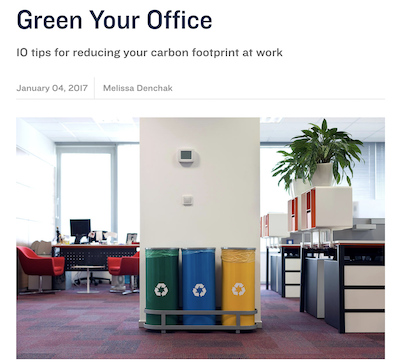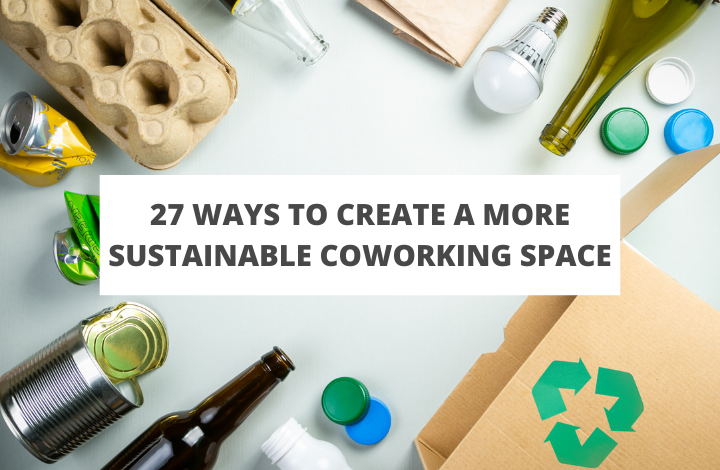Every day is Earth Day, right?
Right.
It’s important to be mindful of the environmental impact we make, as individuals and as workspace communities every day in every way.
This month, we’re focusing on green initiatives and sustainability in coworking spaces with a special Coworking Convo on April 30 and a blog series with tips and resources for coworking space operators.
We’ve rounded up 27+ top tips for greening an office space from the teams at the NRDC, AMEX and more.
Do you have tips to add to the list? Share them in the comments and we’ll include them.

- Create a Green Team: “Recommendations have more sway coming from a green team…Individuals might not have as much power.”
- Encourage recycling and composting: “If your office doesn’t have a recycling program, work with your office manager and custodial staff to set one up for paper, aluminum cans, and plastic bottles and containers. Push for composting, too.”
- Break the paper habit: “Spend less time in the copy room…push your office to buy paper that is made with 100 percent post-consumer recycled content rather than produced with virgin materials…[and] encourage your coworkers to recycle paper trash to keep it out of landfills.”
- Optimize printing: “When printing is a must, fit more text per page by reducing margin sizes and type sizes. Set computers and copiers to a double-sided printing mode, or print on the back of previously printed paper. To cut down on ink, print in black and white and in draft mode.”
- Curb office equipment energy consumption: “Configure your devices to automatically enter low-power modes when idle, and remember that anything plugged in sucks energy, even when turned off.”
- Turn off lights: “Doing so in unoccupied public spaces like bathrooms, kitchens, and conference rooms not only conserves energy but can start (or reinforce) a good habit in coworkers.”
- Say no to single-use utensils and unnecessary food packaging: “Eliminate waste by bringing lunch from home in reusable containers (skip the plastic wrap and aluminum foil) and by keeping a set of cutlery, a couple of dishes, a mug, and a cloth napkin at your desk.”
- Reduce water and paper towel waste: “A running faucet releases about five gallons of water every two minutes. Running a full dishwasher load uses up to 30 percent less water than washing dishes by hand. And dry your hands with a cloth towel. If paper towels are your only option, use just one then compost it, if possible.”
- Caffeinate conscientiously: “When brewing a pot of joe, opt for reusable filters and fair-trade-certified, shade-grown coffee. Turn off the coffeemaker at the end of the day and over the weekend…and skip the disposable coffee pods such as K-cups, or buy reusable pods.”
- Rethink your commute and work-related travel: “Whenever possible, walk, bike, carpool, or use buses, trains, or light rail to get to work. If commuting by car is unavoidable, invest in a fuel-efficient vehicle. And reduce work-related travel by “meeting” with far-flung colleagues via videoconferencing and other technologies when you can.”

- Stock reusable pens: “U.S. citizens alone throw out over four million disposable pens — daily. Consider stocking the office with reusable pens instead.”
- Keep tabs on the supply cabinet: “Keep the office supply cabinet under the direct supervision of one or two people. In doing this, employees won’t be as wasteful of supplies as they may otherwise be…To sweeten the pot, you could set up a program that uses the money saved in conserving office supplies to throw office parties or lunches for everybody.”
- Go digital: “Is it necessary to print out a meeting agenda for every member? Or can you incorporate it into a slide show, or simply send it via email?”
- Power down: “Would you believe that the majority of office power is consumed by machines that are off, but still plugged into a live outlet? Standby power (or phantom power) is a huge — and hugely unnecessary — environmental culprit and expense.”
Greening Your Space: Pro Tips and Strategies | Coworking Convo | April 30 | Free
- Consider solar power: “Yes, solar energy systems can be expensive, and aren’t always practical depending on your office location and setup. But you can reap some long-term savings from your initial investment, and many states now offer incentives (like rebates and the ability to sell excess energy to the power company) for solar energy users.”
- Use natural light: “Artificial lighting represents 40 percent of electricity consumption in a typical office building, and almost a quarter of all electricity in the States. And so often this is unnecessary. Open the blinds and let daylight in wherever possible.”
- Install motion sensors: “Take a walk around your office and notice how many offices and conference rooms have lights on despite nobody using the space. Instead of leaving it to employees to turn off lights as they leave rooms, install motion-activated light switches.”
- Decorate with light colors: “By using light wall colors and high-gloss sheens, daylight is more easily reflected off the walls, and less artificial light is necessary.”
- Use compact fluorescent bulbs: “Compact fluorescent bulbs use 75 percent less energy than incandescent bulbs, and they last about 10 times longer. So you’ll save on energy costs, replacement bulb costs, and reduce waste by using them.”
- Use multi-purpose machines: “Each piece of office equipment you buy produces heaps of toxic substances in both the manufacturing and disposal stages. So the fewer office machines you buy, the smaller your footprint will be.”
- Buy second-hand: “It’s not always possible…but every time you buy something for the office that’s second-hand, you’ll save by-product wastage in the production of a new appliance (and you’ll save money too).”
- Watch the temperature in summer: “Most offices could stand to raise the temperature a few degrees. In fact, look at how many people in the office (usually women) keep sweaters and extra clothing at their desks at the height of summer because the office is so much colder than the outside temperature.”
- Use portable air conditioners: “You can save lots of power and money by using portable air conditioners…Cooling only the areas that need it with portable air conditioners allows employees to set comfortable temperatures for each area.”
- Reduce toilet water consumption: “Reduce the amount of water used per flush by putting a brick in the tank. If you are replacing toilets, look for low-flush models, or ones with a half-flush option. Toilet flushing is the largest water consumer in office buildings.”
- Install aerators: “Make sure all taps have low-flow aerators installed to reduce water wastage.”
- Use green cleaning products: “Environmentally friendly cleaning products protect the health of not only your cleaning staff but also your employees, by eliminating harmful substances and odors from the office.”
- Go green — literally: “Make your office literally green with plants! They absorb airborne pollutants (which are rampant with off-gassing office furniture), and emit healthy negative ions and oxygen into the air.”
Bonus:
In addition to greening your coworking space, there are lots of things we can do as individuals to reduce our personal carbon footprint. Here are 35 of the easiest ones, as shared by the Columbia Climate School.
Next Step
Join us on April 30 for a free Coworking Convo on greening your space.
Gain community building skills in 5 minutes a week
with weekly letters from Cat





